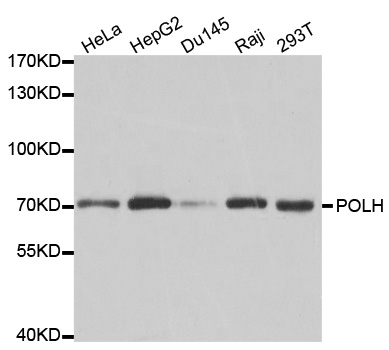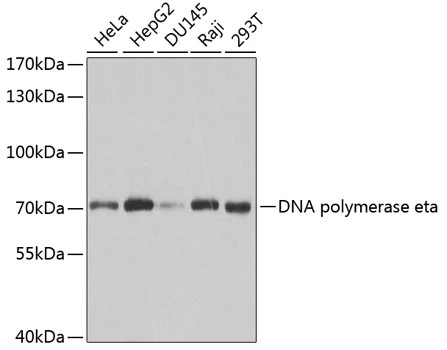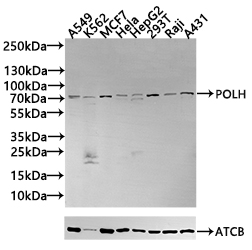POLH antibody [N1N3]
GTX109938
ApplicationsWestern Blot, ImmunoHistoChemistry, ImmunoHistoChemistry Paraffin
Product group Antibodies
ReactivityHuman
TargetPOLH
Overview
- SupplierGeneTex
- Product NamePOLH antibody [N1N3]
- Delivery Days Customer9
- Application Supplier NoteWB: 1:500-1:3000. IHC-P: 1:100-1:1000. *Optimal dilutions/concentrations should be determined by the researcher.Not tested in other applications.
- ApplicationsWestern Blot, ImmunoHistoChemistry, ImmunoHistoChemistry Paraffin
- CertificationResearch Use Only
- ClonalityPolyclonal
- Concentration1 mg/ml
- ConjugateUnconjugated
- Gene ID5429
- Target namePOLH
- Target descriptionDNA polymerase eta
- Target synonymsRAD30, RAD30A, XP-V, XPV, DNA polymerase eta, DNA polymerase eta transcript, RAD30 homolog A, polymerase (DNA directed), eta, polymerase (DNA) eta, xeroderma pigmentosum variant type protein
- HostRabbit
- IsotypeIgG
- Protein IDQ9Y253
- Protein NameDNA polymerase eta
- Scientific DescriptionThis gene encodes a member of the Y family of specialized DNA polymerases. It copies undamaged DNA with a lower fidelity than other DNA-directed polymerases. However, it accurately replicates UV-damaged DNA; when thymine dimers are present, this polymerase inserts the complementary nucleotides in the newly synthesized DNA, thereby bypassing the lesion and suppressing the mutagenic effect of UV-induced DNA damage. This polymerase is thought to be involved in hypermutation during immunoglobulin class switch recombination. Mutations in this gene result in XPV, a variant type of xeroderma pigmentosum. [provided by RefSeq]
- ReactivityHuman
- Storage Instruction-20°C or -80°C,2°C to 8°C
- UNSPSC12352203
References
- Ning K, Kuz CA, Cheng F, et al. Adeno-Associated Virus Monoinfection Induces a DNA Damage Response and DNA Repair That Contributes to Viral DNA Replication. mBio. 2023,14(1):e0352822. doi: 10.1128/mbio.03528-22Read this paper



![WB analysis of various samples using GTX00871 POLH antibody [5H10]. Lane 1 : Recombinant full-size Pol eta (POLH) with 6XHis tag at C-teminus Lnae 2 : HeLa whole cell lysate (~40 microg) Lane 3 : XP2SA (XP-V) whole cell lysate (~40 microg)](https://www.genetex.com/upload/website/prouct_img/normal/GTX00871/GTX00871_20200406_AP_001_85_w_23053121_995.webp)



